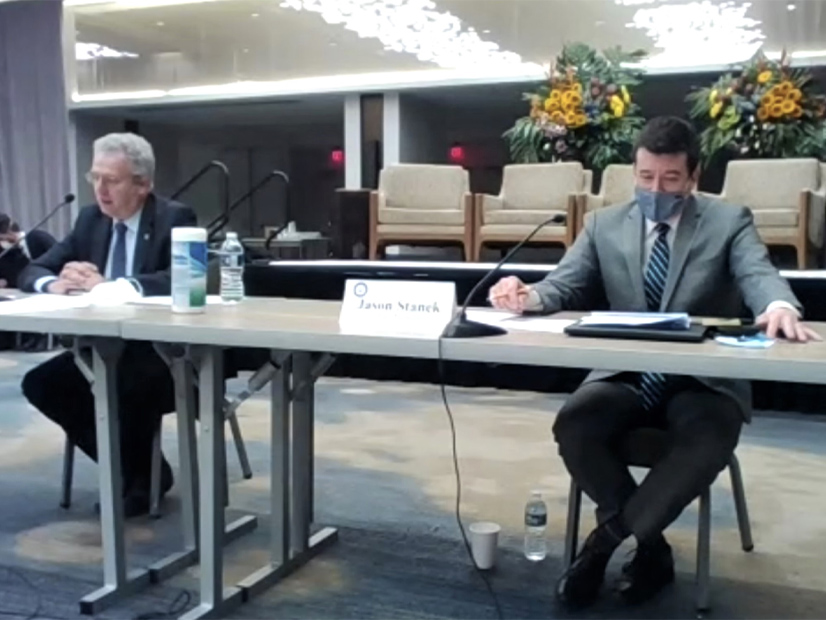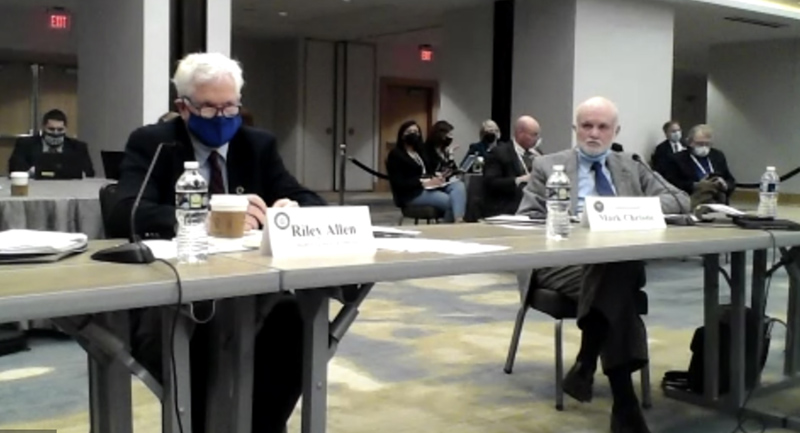
The second meeting of a federal-state task force convened to spur transmission buildout exposed differences among regulators over how FERC could expand the menu of recognized transmission benefits when allocating costs for new projects.
The stickiest topic during Wednesday’s Joint Federal-State Task Force on Electric Transmission meeting in D.C. was how to divvy the costs of regional transmission projects that advance state public policy goals.
“We decided to go with the non-controversial, easy subject: transmission cost allocation,” FERC Chairman Richard Glick joked as he opened the meeting. “Everyone wants more transmission; no one wants to pay for it.”
A collaboration between FERC and the National Association of Regulatory Utility Commissioners, the task force could produce recommendations for new regulatory language or initiatives to improve transmission development. The team first met in November. (See FERC-State Tx Task Force Begins Work.)
Glick said FERC is interested in whether regions are fully assessing all the benefits associated with new transmission. Although the commission has broad authority in prescribing cost allocation, state cooperation is vital, he said.
“It would be foolish to think that we could do whatever we want and go home,” Glick said, noting that states wield authority over siting. “It’s vital that we go into this arm-in-arm and find something we can live with.”
Maryland Public Service Commission Chair Jason Stanek, task force co-chair alongside Glick, likened the discomfort with discussing allocation to the situation when a single bill arrives for large party of diners. He said the task force is focusing on how to split more nebulous transmission benefits like societal benefits, economic gains and cleaner air.
Matthew Nelson, chair of the Massachusetts Department of Public Utilities, said he saw nothing wrong with dividing a dinner bill based on who had a “more expensive meal or had a beverage with their dinner,” given that some states have more ambitious emissions-reduction and renewable energy targets.
But Glick pushed back against that idea. “It isn’t just the public policy goals that are achieved when projects are built in part to satisfy those public policy goals. There are other benefits — resilience, reliability, economics and so on,” he said.
The FERC chair also reminded the task force that quantifying benefits for allocation is both an “art and science.” He expressed optimism that the task force can isolate benefit measurements with a degree of certainty.
Stanek shared optimism that many benefits have “a price tag associated with them” and said sharper forecasting capabilities and better modeling tools are available today. He suggested that regulators solicit NERC’s input to conduct regional analyses “in order to award potential transmission projects with some quantifiable benefits.”
Glick agreed with that approach. “We need to figure out ways to expand the list of benefits that we are looking at … to be more granular in terms of type of benefits we are looking at, but also in terms of being able to better assess the value of those benefits and, more importantly, who benefits.”
IDing Necessary Tx Projects
The task force also pondered whether the three major drivers for building transmission — reliability, economics and public policy — should be expanded.
California Public Utilities Commissioner Clifford Rechtschaffen requested FERC issue guidance on additional types of benefits and methods for assessing them.
He suggested the reliability category should be opened to grid hardening projects; the economic category should include projects that facilitate improved connectivity to lower-cost generation and reduce market power; and the public policy category should be extended to projects that further a clean energy transition.
Rechtschaffen also argued that FERC guidance should extend the time frame for measuring benefits to 15 or 20 — or longer. “This better corresponds to longer-range goals such as renewables integration and emissions reduction targets,” he said.
Glick said the traditional, siloed approach to transmission cost-sharing makes less sense going forward. He said projects earmarked for one benefit often deliver other benefits once built.
“This idea that we can just plan for and allocate costs for transmission based on one particular set of benefits is probably a little bit outdated and doesn’t mix with reality,” he said.

FERC Commissioner Mark Christie cautioned that defining benefits too generally risks the construction of unnecessary transmission projects and extraneous costs to ratepayers. He also said directing RTOs to plan on a 15-year horizon seems uncomfortably close to the states’ integrated resource planning (IRP) processes.
“I would caution [that] looking at a 15-year holistic plan sounds like an IRP, and states are set up to do IRPs, and I don’t know the RTOs are set up to do IRPs,” Christie said. “Do you want RTOs to become integrated planners?”
In that scenario, Christie said, “money would begin to flow” on projects in an RTO’s regional plan before states had a chance to weigh in. As an example, he said Indiana ratepayers should not pay for a portion of a billion-dollar transmission line that serves a Virginia renewable portfolio standard.
In recapping the meeting, Stanek noted several members had brought up the importance of grid resilience and adding that as a new category in allocating costs.
“There’s a lot of benefits that are hard to quantify, but perhaps resilience is one topic where we could have some asymetrics on a regional basis, as opposed to a one-size-fits-all in terms of resilience for the country,” he said.
Consent Role for States
Christie asked state commissioners whether they should have a role in approving grid operators’ cost-allocation methodologies.
Kansas Corporation Commission Chair Andrew French recalled the praise he offered SPP during the first task force meeting.
“[SPP] offers the broadest, or one of the broadest, sets of rights to its state regulators and involves them in the cost allocation process, resource adequacy process and other items,” he said. “We have primary authority for setting the basis of any regional cost allocation.”
French said the RTO typically defers to decisions of the Regional State Committee (RSC), as it did last month when the RSC and the board approved fixes to FERC-identified deficiencies in the local facility cost-allocation process that had previously been contested by stakeholders. (See SPP Board of Directors/Members Committee Briefs: Jan. 25, 2022.)
“To the question of whether there should be a rigid consent of the states for cost allocation, that is tough,” French said. “I would exercise caution in saying our region, or any region, should have to reach consent of every single state before agreeing on cost-allocation methodology. There are going to have to be a lot of discussions and negotiations between lots of different counterparties to figure out what works and, ultimately, it would be ideal to come up with a framework that you could put in place for multiple iterations of similar planning processes in the future.”
North Carolina Utilities Commissioner Kimberly Duffley said that FERC should consider giving states a consent role but reminded her peers that not every state is the same.
“I think the concern for states is that they would have no control over their own destiny and their own costs,” she said. “We also need to think about equity issues and energy burden issues when you’re looking at this problem, because there are many states that have a much higher energy burden than other states. Asking them to take on another state’s public policy goal when they’re struggling to maintain the costs when reliability is the main driver is a hard pill to swallow.”

French cautioned against using “lists of dozens of different benefits that transmission can provide” as justification for a plethora of projects.
“I think that we should exercise a little bit of caution [rather than] just saying, ‘We are going to plan on using all of these benefits and we are going to build every single project,’” he said.
Arkansas Public Service Commission Chair Ted Thomas called for a “rigorous review” of benefits identification instead of relying on postage stamp rates.
“To make this process work, one of the things we need is common ground between those who see a policy imperative for building transmission and those who are worried about a fair deal and fuzzy benefits on the other side,” he said. “How you bridge that gap, I think, starts with identifying these benefits.”
FERC’s Willie Phillips said that as a new commissioner he’s interested in balancing energy sustainability with affordability. “Having grown up in rural Alabama, I know firsthand how any cost increase can affect customers and that affordability is a critical backbone to economic development.”


